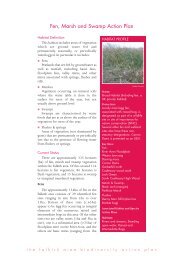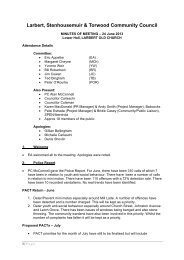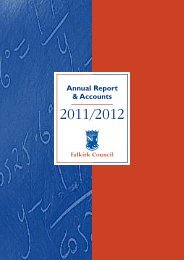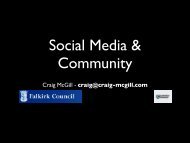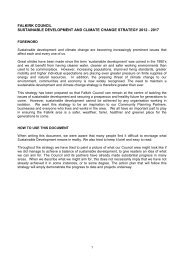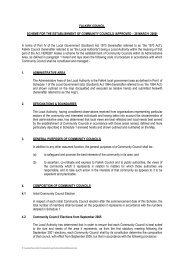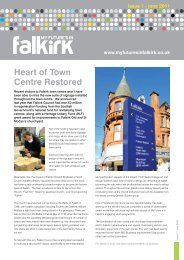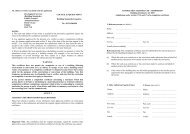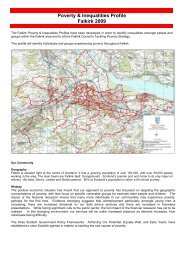The AnTonine WAll - Falkirk Council
The AnTonine WAll - Falkirk Council
The AnTonine WAll - Falkirk Council
Create successful ePaper yourself
Turn your PDF publications into a flip-book with our unique Google optimized e-Paper software.
initiatives such as the John Muir Way and<br />
link to walks along the canal. Identifying, in<br />
consultation with landowners, potential routes<br />
and access agreements might come next.<br />
Managing the Complexity<br />
26. One of the key challenges in managing the<br />
Antonine Wall is handling the many different<br />
aspects, and trying to co-ordinate the myriad<br />
of agencies and groups with relevant interests.<br />
At present there are many separate strategies<br />
relating to aspects of the management of the<br />
WHS, already prepared or underway. As well as<br />
securing a common framework so that these<br />
component parts support one another, it will be<br />
essential to delegate responsibilities – in the way<br />
that the Supplementary Planning Guidance has<br />
become part of the Development Plan of each<br />
local authority.<br />
27. For the Management Plan itself, the risk with a<br />
logical hierarchical approach to planning is that<br />
with 6 main Aims, each of which is then fleshed<br />
out with successive layers of Issues, Objectives,<br />
and Actions, the result is a vast number of things<br />
to try to do simultaneously. When the core<br />
resource for the Antonine Wall is just one<br />
Co-ordinator, there is a need to try to find more<br />
of a focus.<br />
28. Following the themes of the Steering Group<br />
and Stakeholder sessions to be realistic about<br />
likely resource levels, and where possible to<br />
secure multiple benefits from the actions taken,<br />
the following suggestions distilled from the<br />
workshops illustrate a range of potential early<br />
action priorities:<br />
• a long-distance walking route: start with<br />
signs marking the full route of the Wall, and<br />
existing and proposed path networks; then<br />
explore the further potential in consultation<br />
with landowners, with a view to access<br />
agreements, and improving access and<br />
facilities along the Wall.<br />
• visitor centres: start with existing facilities,<br />
and the scope for more replicas following<br />
the success of the Bridgeness Slab. Relate<br />
to the history of the locality, and explain<br />
the timelines, and include the potential for<br />
reconstructions.<br />
• improved communications: start by updating<br />
the current website, then examine<br />
a range of digital and traditional media to<br />
report on the consultation workshops<br />
43<br />
enhance how to share and disseminate<br />
information.<br />
• networking: start with an annual event –<br />
a seminar for both researchers and interest<br />
groups to exchange ideas and information;<br />
explore options such as setting up a Friends<br />
of the Antonine Wall, and a Facebook page.<br />
• education: produce a pack for teachers;<br />
and develop the potential for school visits,<br />
especially drawing on volunteer resources<br />
to enable lively and memorable hands-on<br />
experiences, and telling a Scottish as well<br />
as a Roman story.<br />
Criteria for Project Selection<br />
29. In the last consultation sessions, participants<br />
noted that projects might come forward<br />
which had not been envisaged as part of the<br />
Management Plan. While it was not formally<br />
discussed, the tenor of the consultation<br />
responses make it feasible to suggest the kind<br />
of criteria which would be appropriate to guide<br />
project design and selection. <strong>The</strong> questions<br />
to ask are whether a proposed project would<br />
contribute to the WHS by:<br />
• Securing its protection and enhancement<br />
• Improving its visibility and interpretation<br />
• Aiding communication and its educational<br />
and research roles<br />
• Enhancing facilities for recreation, enjoyment<br />
and tourism<br />
• Being economically sustainable (in terms of<br />
benefits and maintenance costs)<br />
• Strengthening connections, both locally and<br />
further afield.<br />
Acknowledgements<br />
30. Thanks are due to everyone who took part in<br />
this consultation process. This includes everyone<br />
from public bodies who came to contribute and<br />
to listen, including those who hosted the various<br />
events; and the members of the public and a<br />
wide range of community organisations who<br />
gave up an evening or an afternoon to contribute<br />
to the discussions. Inevitably this report has had<br />
to be selective, but it is hoped that it reflects the<br />
main points and the supportive mood which<br />
pervaded this whole process.<br />
Tim Birley<br />
12 December 2012



